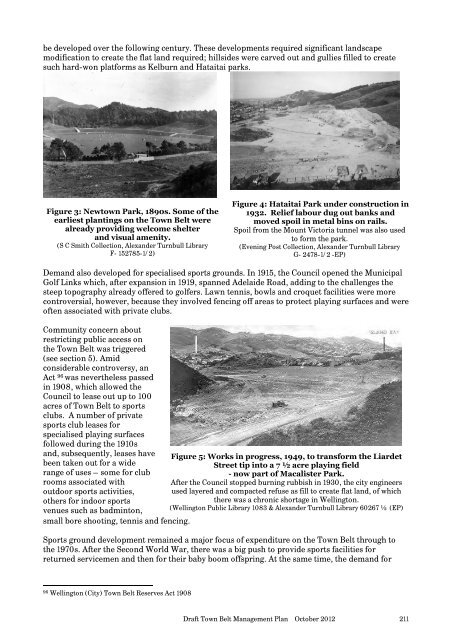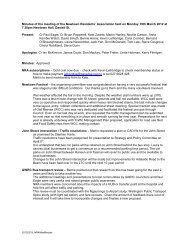Draft Town Belt Management Plan - Wellington City Council
Draft Town Belt Management Plan - Wellington City Council
Draft Town Belt Management Plan - Wellington City Council
Create successful ePaper yourself
Turn your PDF publications into a flip-book with our unique Google optimized e-Paper software.
e developed over the following century. These developments required significant landscape<br />
modification to create the flat land required; hillsides were carved out and gullies filled to create<br />
such hard-won platforms as Kelburn and Hataitai parks.<br />
Figure 3: Newtown Park, 1890s. Some of the<br />
earliest plantings on the <strong>Town</strong> <strong>Belt</strong> were<br />
already providing welcome shelter<br />
and visual amenity.<br />
(S C Smith Collection, Alexander Turnbull Library<br />
F- 152785-1/2)<br />
Figure 4: Hataitai Park under construction in<br />
1932. Relief labour dug out banks and<br />
moved spoil in metal bins on rails.<br />
Spoil from the Mount Victoria tunnel was also used<br />
to form the park.<br />
(Evening Post Collection, Alexander Turnbull Library<br />
G- 2478-1/2 -EP)<br />
Demand also developed for specialised sports grounds. In 1915, the <strong>Council</strong> opened the Municipal<br />
Golf Links which, after expansion in 1919, spanned Adelaide Road, adding to the challenges the<br />
steep topography already offered to golfers. Lawn tennis, bowls and croquet facilities were more<br />
controversial, however, because they involved fencing off areas to protect playing surfaces and were<br />
often associated with private clubs.<br />
Community concern about<br />
restricting public access on<br />
the <strong>Town</strong> <strong>Belt</strong> was triggered<br />
(see section 5). Amid<br />
considerable controversy, an<br />
Act 96 was nevertheless passed<br />
in 1908, which allowed the<br />
<strong>Council</strong> to lease out up to 100<br />
acres of <strong>Town</strong> <strong>Belt</strong> to sports<br />
clubs. A number of private<br />
sports club leases for<br />
specialised playing surfaces<br />
followed during the 1910s<br />
and, subsequently, leases have<br />
been taken out for a wide<br />
range of uses – some for club<br />
rooms associated with<br />
outdoor sports activities,<br />
others for indoor sports<br />
venues such as badminton,<br />
small bore shooting, tennis and fencing.<br />
Figure 5: Works in progress, 1949, to transform the Liardet<br />
Street tip into a 7 ½ acre playing field<br />
- now part of Macalister Park.<br />
After the <strong>Council</strong> stopped burning rubbish in 1930, the city engineers<br />
used layered and compacted refuse as fill to create flat land, of which<br />
there was a chronic shortage in <strong>Wellington</strong>.<br />
(<strong>Wellington</strong> Public Library 1083 & Alexander Turnbull Library 60267 ½ (EP)<br />
Sports ground development remained a major focus of expenditure on the <strong>Town</strong> <strong>Belt</strong> through to<br />
the 1970s. After the Second World War, there was a big push to provide sports facilities for<br />
returned servicemen and then for their baby boom offspring. At the same time, the demand for<br />
96 <strong>Wellington</strong> (<strong>City</strong>) <strong>Town</strong> <strong>Belt</strong> Reserves Act 1908<br />
<strong>Draft</strong> <strong>Town</strong> <strong>Belt</strong> <strong>Management</strong> <strong>Plan</strong> October 2012<br />
211





